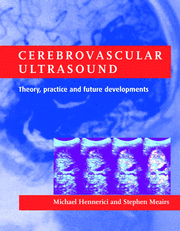Book contents
- Frontmatter
- Dedication
- Contents
- List of contributors
- Preface
- PART I ULTRASOUND PHYSICS, TECHNOLOGY AND HEMODYNAMICS
- PART II CLINICAL CEREBROVASCULAR ULTRASOUND
- (i) Atherosclerosis: pathogenesis, early assessment and follow-up with ultrasound
- (ii) Extracranial cerebrovascular applications
- (iii) Intracranial cerebrovascular applications
- 18 Transcranial Doppler ultrasonography and vasospasm after subarachnoid hemorrhage
- 19 Intracranial cerebral artery stenosis and occlusion
- 20 Arteriovenous malformations
- 21 High intensity transient signals
- 22 Transcranial Doppler monitoring during carotid endarterectomy
- 23 Cerebral vasoreactivity
- 24 Intracranial venous diseases: the role of ultrasound
- PART III NEW AND FUTURE DEVELOPMENTS
- Index
21 - High intensity transient signals
from (iii) - Intracranial cerebrovascular applications
Published online by Cambridge University Press: 05 July 2014
- Frontmatter
- Dedication
- Contents
- List of contributors
- Preface
- PART I ULTRASOUND PHYSICS, TECHNOLOGY AND HEMODYNAMICS
- PART II CLINICAL CEREBROVASCULAR ULTRASOUND
- (i) Atherosclerosis: pathogenesis, early assessment and follow-up with ultrasound
- (ii) Extracranial cerebrovascular applications
- (iii) Intracranial cerebrovascular applications
- 18 Transcranial Doppler ultrasonography and vasospasm after subarachnoid hemorrhage
- 19 Intracranial cerebral artery stenosis and occlusion
- 20 Arteriovenous malformations
- 21 High intensity transient signals
- 22 Transcranial Doppler monitoring during carotid endarterectomy
- 23 Cerebral vasoreactivity
- 24 Intracranial venous diseases: the role of ultrasound
- PART III NEW AND FUTURE DEVELOPMENTS
- Index
Summary
Introduction
Transcranial Doppler sonography (TCD), introduced by Aaslid in 1982 (Aaslid et al., 1982), has found wide acceptance as a valuable tool for evaluation of cerebral hemodynamics in a variety of clinical settings. An unexpected use of TCD was reported by Spencer in 1990. Stemming from his early work in 1969 on transcutaneous ultrasonographic detection of air bubbles evoked by decompression (Spencer et al., 1969), he described a new application of TCD for detection of middle cerebral artery emboli during carotid endarterectomy (Spencer et al., 1990a). Subsequent investigation of this interesting new technique verified the ability of TCD to detect high intensity transient signals, commonly known as HITS, corresponding to both gaseous and solid microembolic materials. The methodology for detection and differentiation of HITS has made considerable progress over the last several years. Early questions regarding the physical nature of HITS, i.e. artefact vs. microembolic material, have now been superseded by those relevant to the potential role of HITS monitoring for identification of patients with an increased risk of stroke (Hennerici, 1994). This chapter will describe characteristic features of HITS, discuss the influence of TCD methodology on HITS detection and comment on the pathophysiologic significance of these signals. It will then address the utility of current clinical applications for HITS monitoring.
Technical methodology for detection and characterization of HITS
A sine qua non of a HITS is the typical sound, which can be described as a sudden ‘chirp’, ‘snap’ or exceptionally ‘moan’.
- Type
- Chapter
- Information
- Cerebrovascular UltrasoundTheory, Practice and Future Developments, pp. 297 - 316Publisher: Cambridge University PressPrint publication year: 2001
- 1
- Cited by



